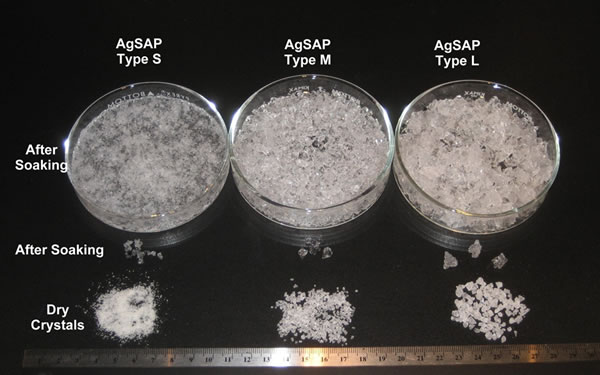Potassium polyacrylate and sodium polyacrylate are both superabsorbent polymers, but they differ in terms of the cation they contain. The key difference lies in the type of ion they use to balance the negative charge of the polyacrylate chain.

Potassium Polyacrylate: This polymer contains potassium ions (K+) as the counter ion to balance the negatively charged polyacrylate backbone. Potassium polyacrylate is often used in agriculture, horticulture, and gardening as a water-retaining agent in soils to improve water retention and reduce irrigation frequency.
Sodium Polyacrylate: Conversely, sodium polyacrylate contains sodium ions (Na+) to balance the negative charges of the polyacrylate chains. It is commonly used in consumer products such as diapers, sanitary pads, and as a water-absorbing material in various industrial applications.
Polyacrylate is an important synthetic polymer and a derivative of polyacrylic acid. It is usually produced by polymerizing propenoic acid monomer and has a variety of applications, including medicine, industry and daily necessities.
Is Potassium polyacrylate and sodium polyacrylate safely?
Potassium polyacrylate and sodium polyacrylate are generally considered safe materials with NO toxicity. However, their safety and degradability depend on various factors such as the specific formulation, use case, and environmental conditions.
Safety:
Human Safety: Both potassium polyacrylate and sodium polyacrylate are commonly used in consumer products such as diapers, sanitary pads, and soil conditioners. They have been extensively tested for human safety and are generally regarded as non-toxic. However, prolonged exposure or ingestion in large amounts can still lead to gastrointestinal irritation.
Environmental Safety: When used in soil conditioners or agricultural applications, these polymers can improve water retention and reduce water usage, which can be environmentally beneficial. However, their environmental impact depends on factors like disposal methods, concentrations used, and potential for accumulation in the ecosystem.
Degradability:
Biodegradability: Polyacrylates are generally not biodegradable under typical environmental conditions. They are synthetic polymers that resist microbial breakdown, especially in anaerobic environments such as landfills.
Decomposition: While these polymers may not biodegrade readily, they can undergo physical processes like photodegradation or hydrolysis over a long period. However, the degradation process is slow and may not fully break down the polymer into harmless substances.
Environmental Impact: The slow degradation of polyacrylates can lead to concerns about their persistence in the environment, especially if large quantities are released without proper management. Microplastics from degraded polymers can also pose risks to aquatic life and ecosystems.
In summary, potassium polyacrylate and sodium polyacrylate are generally safe for use in consumer products and agriculture when used appropriately. However, their slow degradation and potential environmental persistence raise concerns about long-term impacts, emphasizing the importance of responsible use, disposal, and further research into biodegradable alternatives.
Introduction to polyacrylate:
Chemical structure: The main structure of polyacrylate is formed by the polymerization reaction of acrylic monomer (also called acrylic acid). This polymer contains repeating acrylic groups in its molecular structure.
Physical properties: Polyacrylate is usually a colorless and odorless solid with good heat resistance and chemical stability. It can maintain stability under different temperatures and environmental conditions, and has a certain degree of flexibility and plasticity.
Application areas: Polyacrylates are widely used in the medical field, such as in the manufacture of medical dressings, surgical supplies and medical equipment. It is also used in industry in the manufacture of coatings, adhesives, sealants and other products. In addition, polyacrylates are also used in some daily necessities, such as lubricants, surface treatment agents, etc.
Special types: In the category of polyacrylates, there are also some special types of polymers, such as crosslinked polyacrylates, which have higher mechanical strength and water absorption and are often used in hydrogels and water absorption. materials and other fields.
In general, polyacrylate is a multifunctional polymer with broad application prospects and important industrial value.
The choice between potassium polyacrylate and sodium polyacrylate depends on the intended application and the specific properties required. Potassium polyacrylate is preferred for soil improvement and water retention purposes, while sodium polyacrylate is utilized for its high water absorption capacity in products like diapers and absorbent pads.

